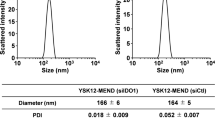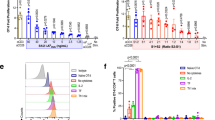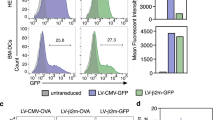Abstract
The use of tumor antigen loaded dendritic cells (DC) is one of the most promising approaches to induce a tumor specific immune response in vivo. Several strategies have been designed to load DC with tumor antigens. In this study, we investigated the delivery of in vitro transcribed RNA and plasmid DNA into monocyte-derived, ie non-proliferating human DC, using several nonviral transfection methods including electroporation and lipofection. Green fluorescent protein (GFP) was used as a reporter gene and influenza matrix protein 1 (M1) as a model antigen for HLA class I restricted antigen presentation. Using electroporation in combination with DNA or with RNA, up to 11% of DC were GFP-positive. Using liposomes as a vehicle for DNA transport up to 10% of the DC were GFP-positive. A significant increase in transfection efficacy, of up to 20%, was observed when GFP RNA was used in combination with liposomes. Importantly, the RNA transfected DC retained their typical morphological and immunophenotypical characteristics. In addition, DC transfected with M1 RNA were able to stimulate autologous peripheral M1-specific memory cytotoxic T lymphocytes (CTL), as well as M1-specific CTL clones. Furthermore, comparison of DNA-transfected DC with RNA-transfected DC revealed the latter to be far better stimulators of antigen-specific T cells. This RNA transfection technique consequently represents a very promising tool for future immunotherapy strategies.
This is a preview of subscription content, access via your institution
Access options
Subscribe to this journal
Receive 12 print issues and online access
$259.00 per year
only $21.58 per issue
Buy this article
- Purchase on Springer Link
- Instant access to full article PDF
Prices may be subject to local taxes which are calculated during checkout




Similar content being viewed by others
References
Romero P et al. Ex vivo staining of metastatic lymph nodes by class I major histocompatibility complex tetramers reveals high numbers of antigen-experienced tumor-specific cytolytic T lymphocytes J Exp Med 1998 188: 1641–1650
Speiser DE et al. In vivo expression of natural killer cell inhibitory receptors by human melanoma-specific cytolytic T lymphocytes J Exp Med 1999 190: 775–782
Lee PP et al. Characterization of circulating T cells specific for tumor-associated antigens in melanoma patients Nature Med 1999 5: 677–685
Doyle A et al. Markedly decreased expression of class I histocompatibility antigens, protein, and mRNA in human small-cell lung cancer J Exp Med 1985 161: 1135–1151
Banchereau J, Steinman RM . Dendritic cells and the control of immunity Nature 1998 392: 245–252
Steinman RM . Dendritic cells. In: Paul WE (ed) Fundamental Immunology Lippincott-Raven: Philadelphia 1999 pp 547–573
Schuler G, Steinman RM . Dendritic cells as adjuvants for immune-mediated resistance to tumors J Exp Med 1997 186: 1183–1187
Mayordomo JI et al. Bone marrow-derived dendritic cells pulsed with synthetic tumor peptides elicit protective and therapeutic antitumor immunity Nature Med 1995 1: 1297–1302
Hsu FJ et al. Vaccination of patients with B cell lymphoma using autologous antigen-pulsed dendritic cells Nature Med 1996 2: 52–58
Murphy G et al. Phase I clinical trial: T cell therapy for prostate cancer using autologous dendritic cells pulsed with HLA-A0201-specific peptides from prostate-specific membrane antigen Prostate 1996 29: 371–380
Nestle FO et al. Vaccination of melanoma patients with peptide- or tumor lysate-pulsed dendritic cells Nature Med 1998 4: 328–332
Marchand M et al. Tumor regressions observed in patients with metastatic melanoma treated with an antigenic peptide encoded by gene MAGe-3 and presented by HLA-A1 Int J Cancer 1999 80: 219–230
Thurner B et al. Intracutaneous vaccination with Mage-3.A1 peptide-pulsed mature monocyte-derived dendritic cells expands specific cytotoxic T cells and induces regression of some metastases in advanced stage IV melanoma J Exp Med 1999 190: 1669–1678
Dhodapkar MV et al. Rapid generation of broad T cell immunity in humans after a single injection of mature dendritic cells J Clin Invest 1999 104: 173–180
Boczkowski D, Nair SK, Snyder D, Gilboa E . Dendritic cells pulsed with RNA are potent antigen-presenting cells in vitro and in vivo J Exp Med 1996 184: 465–472
van Elsas A et al. Peptide-pulsed dendritic cells induce tumoricidal cytotoxic T lymphocytes from healthy donors against stably HLA-A*0201-binding peptides from the Melan-A/MART-1 self antigen Eur J Immunol 1996 26: 1683–1689
Choudhury A et al. Use of leukemic dendritic cells for the generation of antileukemic cellular cytotoxicity against Philadelphia chromosome-positive chronic myelogenous leukemia Blood 1997 89: 1133–1142
Porgador A, Snyder D, Gilboa E . Induction of antitumor immunity using bone marrow-generated dendritic cells J Immunol 1996 156: 2918–2926
Gabrilovich DI, Ciernik IF, Carbone DP . Dendritic cells in antitumor immune responses. I. Defective antigen presentation in tumor-bearing hosts Cell Immunol 1996 170: 101–110
Boon T, van der Bruggen P . Human tumor antigens recognized by T lymphocytes J Exp Med 1996 183: 725–729
Reeves ME et al. Retroviral transduction of human dendritic cells with a tumor-associated antigen gene Cancer Res 1996 56: 5672–5677
Szabolcs P et al. Retrovirally transduced human dendritic cells express a normal phenotype and potent T-cell stimulatory capacity Blood 1997 90: 2160–2167
Verhasselt B et al. Retrovirally transduced CD34++ human cord blood cells generate T cells expressing high levels of the retroviral encoded green fluorescent protein marker in vitro Blood 1998 91: 431–440
Song W et al. Dendritic cells genetically modified with an adenovirus vector encoding the cDNA for a model antigen induce protective and therapeutic antitumor immunity J Exp Med 1997 186: 1247–1256
Wan Y et al. Dendritic cells transduced with an adenoviral vector encoding a model tumor-associated antigen for tumor vaccination Hum Gene Ther 1997 8: 1355–1363
Arthur JF et al. A comparison of gene transfer methods in human dendritic cells Cancer Gene Ther 1997 4: 17–25
Dietz AB, Vuk-Pavlovic S . High efficiency adenovirus-mediated gene transfer to human dendritic cells Blood 1998 91: 392–398
Zhong L, Granelli-Piperno A, Choi Y, Steinman RM . Recombinant adenovirus is an efficient and non-perturbing genetic vector for human dendritic cells Eur J Immunol 1999 29: 964–972
Di Nicola M et al. Gene transfer into human dendritic antigen-presenting cells by vaccinia virus and adenovirus vectors Cancer Gene Ther 1998 5: 350–356
Engelmayer J et al. Vaccinia virus inhibits the maturation of human dendritic cells: a novel mechanism of immune evasion J Immunol 1999 163: 6762–6768
Drillen R, Spehner D, Bohbot A, Hanau D . Vaccinia virus-related events and phenotypic changes after infection of dendritic cells derived from human monocytes Virology 2000 268: 471–481
Tüting T et al. Autologous human monocyte-derived dendritic cells genetically modified to express melanoma antigens elicit primary cytotoxic T cell responses in vitro: enhancement by cotransfection of genes encoding the Th1-biasing cytokines IL-12 and IFN-a J Immunol 1998 160: 1139–1147
Alijagic S et al. Dendritic cells generated from peripheral blood transfected with human tyrosinase induce specific T cell activation Eur J Immunol 1995 25: 3100–3107
Van Tendeloo VF et al. Nonviral transfection of distinct types of human dendritic cells: high-efficiency gene transfer by electroporation into hematopoietic progenitor-, but not monocyte-derived dendritic cells Gene Therapy 1998 5: 700–707
Ashley DM et al. Bone marrow-generated dendritic cells pulsed with tumor extracts or tumor RNA induce antitumor immunity against central nervous system tumors J Exp Med 1997 186: 1177–1182
Nair SK et al. Induction of primary carcinoembryonic antigen (CEA)-specific cytotoxic T lymphocytes in vitro using human dendritic cells transfected with RNA Nat Biotech 1998 16: 364–369
Nair SK et al. Induction of carcinoembryonic antigen (CEA)-specific cytotoxic T-lymphocyte responses in vitro using autologous dendritic cells loaded with CEA peptide or CEA RNA in patients with metastatic malignancies expressing CEA Int J Cancer 1999 82: 121–124
Boczkowski D et al. Induction of tumor immunity and cytotoxic T lymphocyte responses using dendritic cells transfected with messenger RNA amplified from tumor cells Cancer Res 2000 60: 1028–1034
Hoerr I, Obst R, Rammensee HG, Jung G . In vivo application of RNA leads to induction of specific cytotoxic T lymphocytes and antibodies Eur J Immunol 2000 30: 1–7
Heiser A et al. Human dendritic cells transfected with RNA encoding prostate-specific antigen stimulate prostate-specific CTLresponses in vitro J Immunol 2000 164: 5508–5514
Jonuleit H et al. Pro-inflammatory cytokines and prostaglandins induce maturation of potent immunostimulatory dendritic cells under fetal calf serum-free conditions Eur J Immunol 1997 27: 3135–3142
Dunbar PR et al. Direct isolation, phenotyping and cloning of low-frequency antigen-specific cytotoxic T lymphocytes from peripheral blood Curr Biol 1998 8: 413–416
Herr W et al. The use of computer-assisted video image analysis for the quantification of CD8+ T lymphocytes producing tumor necrosis factor alpha spots in response to peptide antigens J Immunol Methods 1997 203: 141–152
Strobel I et al. Efficient expression of the tumor-associated antigen MAGE-3 in human dendritic cells using an avian influenza virus vector Hum Gene Ther 2000 (in press
Acknowledgements
We thank Waltraud Leisgang for technical assistance. We gratefully acknowledge Armin Bender for setting up the ELISPOT technique in the laboratory, for many helpful comments and fruitful discussions. We thank Manfred B Lutz and Heidi C Joao for critical reading of the manuscript. This work was supported by the Bundesministerium für Bildung und Forschung, grant No. 01GE9601, Forschungsverbünde zur somatischen Gentherapie.
Author information
Authors and Affiliations
Rights and permissions
About this article
Cite this article
Strobel, I., Berchtold, S., Götze, A. et al. Human dendritic cells transfected with either RNA or DNA encoding influenza matrix protein M1 differ in their ability to stimulate cytotoxic T lymphocytes. Gene Ther 7, 2028–2035 (2000). https://doi.org/10.1038/sj.gt.3301326
Received:
Accepted:
Published:
Issue Date:
DOI: https://doi.org/10.1038/sj.gt.3301326
Keywords
This article is cited by
-
Dendritic cell-based immunotherapy
Cell Research (2017)
-
Sequence-based approach for rapid identification of cross-clade CD8+ T-cell vaccine candidates from all high-risk HPV strains
3 Biotech (2016)
-
Self-assembled Messenger RNA Nanoparticles (mRNA-NPs) for Efficient Gene Expression
Scientific Reports (2015)
-
Adoptive immunotherapy with MUC1-mRNA transfected dendritic cells and cytotoxic lymphocytes plus gemcitabine for unresectable pancreatic cancer
Journal of Translational Medicine (2014)
-
Langerhans-type and monocyte-derived human dendritic cells have different susceptibilities to mRNA electroporation with distinct effects on maturation and activation: implications for immunogenicity in dendritic cell-based immunotherapy
Journal of Translational Medicine (2013)



